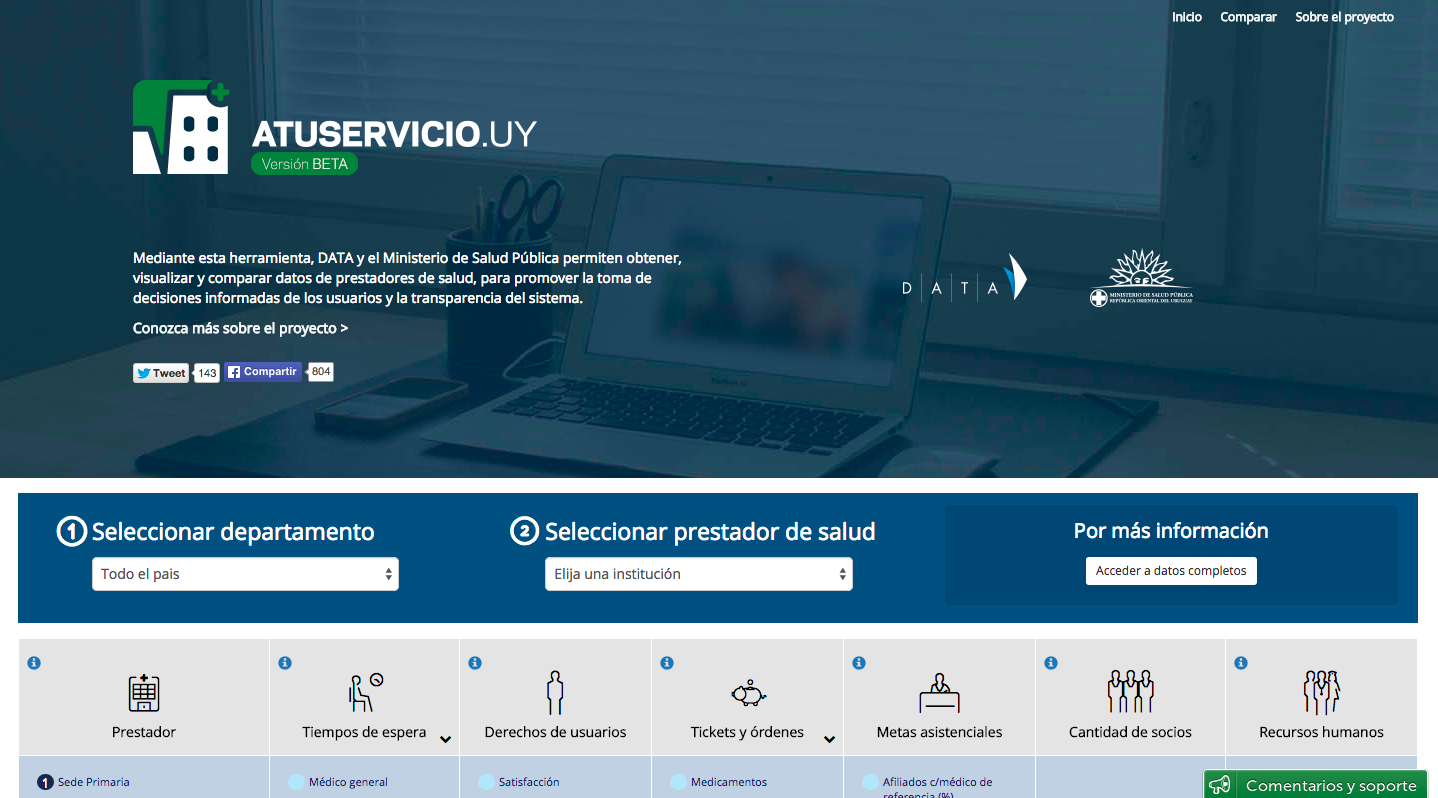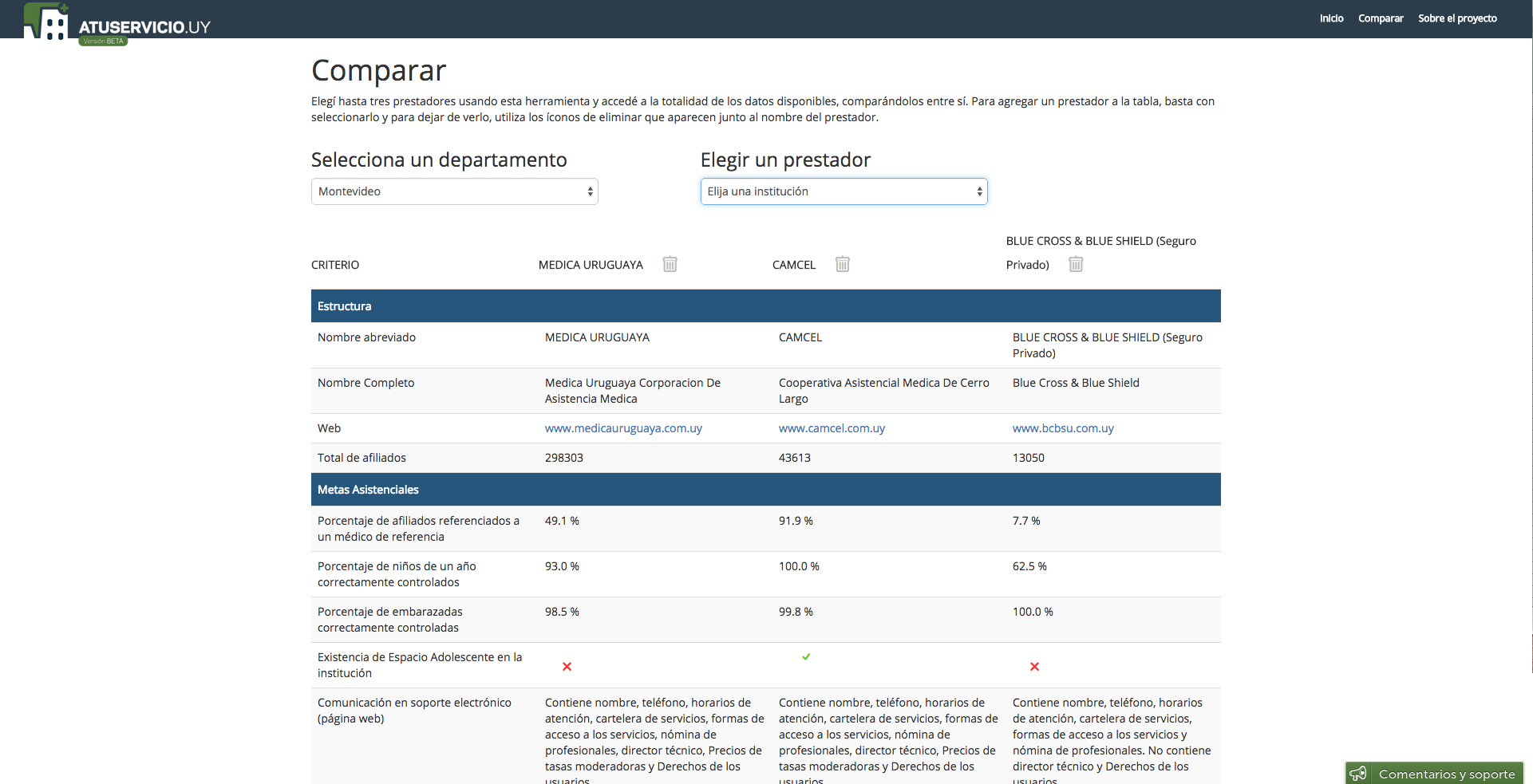In this section, we consider some indicators of impact to determine the success of A Tu Servicio. Since the project – initiated in 2015 and scheduled to run until 2020 – is still in its infancy, any measurements of impact should be considered highly preliminary.
Intended beneficiaries
|
Average Citizens
|
Enabling the people of Uruguay to make better-informed health decisions as a result of actionable information.
Equipping citizens with data-driven evidence and tools to make better decisions on health care choice.
Catalyzing citizens to act as agents of monitoring and evaluation around the health services they receive.
|
|
Health Providers
|
Making clear to citizens which health options are best suited to their needs.
Improving the quality and responsiveness of service based on data-driven demand from citizens.
|
|
Government Agencies
|
Improving the public health system through greater efficiency, transparency and accountability.
|
|
Media
|
Encouraging better data journalism efforts and data driven arguments for public debate on health care.
|
|
Civil Society and Unions
|
Enabling better informed argumentation and advocacy around the status of the health care system.
|
In measuring impact within and across these targeted beneficiaries, we consider three categories:
Use and Awareness
In 2014, before the launch of the application, health care provider data made available by the Ministry of Public Health received fewer than 500 downloads. This low uptake was probably due to limited awareness of the availability of data as well as poor data quality.
Following its launch, the impact of A Tu Servicio was almost immediately apparent. In the first month alone, the site received approximately 35,000 visits, a number equivalent to 1 percent of the total population of Uruguay. The average time spent on the platform was five minutes, and visitors accessed on average five pages per visit.
The launch of A Tu Servicio also increased awareness among Uruguayans regarding the availability of data, and its potential to improve their health care. The application’s launch received widespread media coverage, thanks to a press conference held by DATA Uruguay and the Ministry of Health in which the virtues of the initiative were emphasized. Social media was also employed strategically to disseminate information about the initiative and maintain interest after the launch. Additionally, several unions, including a doctors’ union, endorsed the website, stating the need for more health care information to be made available and accessible.
One aspect in particular of A Tu Servicio received considerable press coverage. Shortly after the launch, journalists and citizens began noticing and drawing attention to long wait times at public hospitals, almost all of which were in contravention of maximum wait times established by the government. The resulting public and media furor resulted in several hospitals changing their practices, and more generally, led to a vigorous public debate about wait times and quality of care in Uruguay.
A Tu Servicio has also played an important role in stimulating and facilitating more informed debate within Uruguay’s Parliament about the future of the nation’s health care system. For example, on August 11, 2015, a nationalist deputy leader of Montevideo, Martin Lema, spoke out against proposed reforms to the National Resources Fund (FNR), which protects citizens against extraordinary health care expenses in Uruguay. In making his case, Lema utilized data from the A Tu Servicio platform to refute the government’s claims that proposed health care reforms would benefit vulnerable populations. He stated that the data showed anyone making this claim was “lying or misinformed.” Lema also publicly criticized the proposed reforms via social media and public interviews, where he continued to cite data from the A Tu Servicio platform to back his case.
Data Quality
As noted earlier, health provider data previously made available by the government was of poor quality, limiting its usability and citizen interest. A Tu Servicio spurred vast improvements in data quality through increased public scrutiny and demand for machine-readable, interoperable and accessible information.
The tool’s user-friendly visualizations helped citizens understand the data in new ways and led to greater public scrutiny and discovery of erroneous data. For the first time, citizens were able to spot errors in the data provided by health providers and, through feedback loops built into the application, request corrections. Instances where health providers had not provided sufficient information were labeled as “not available”; in many cases, citizens could identify such holes in the data and make public requests to the Ministry and private providers for the data to be updated. In addition, the Ministry of Health was able to identify instances where provider data was possibly misrepresented as well as instances where provider data did not agree with crowdsourced user information. Providers made aware of errors have also been able to submit revised and corrected data. After the platform’s launch, Fabrizio Scrollini recalls, “Many [providers] were willing to update their data and standardize it according to our preferences.” Overall, the launch of the application led to a new commitment to data quality on the part of providers, citizens and politicians.
Impact on Other Open Data Projects
Success often breeds success, and the A Tu Servicio project is a good example of how an effective project in one country and sector can spur positive developments in open data elsewhere. The impact of A Tu Servicio on open data progress can be seen in two ways: in other regional projects encouraged by Uruguay’s example; and in other open data projects within Uruguay itself.
Regional and global impact: The most direct evidence of A Tu Servicio’s regional spillover is evident in the Mexican state of Sonora, where DATA Uruguay and Codeando Mexico, another Mexican NGO, have been collaborating with a civil society group on the development of a health care data reporting website aiming to promote a standard for health service delivery. This website, La Rebelion de los Enfermos, gives citizens the ability to report on hospital incidents and provides them with essential information for filing formal complaints. The focus is on creating data standards and exploring further opportunities to open health care information to the public. DATA Uruguay also presented the platform at the Pan American Health Organization, which has used A Tu Servicio as an example of good practice for other health systems in the region. Following international recognition this project has received (for example, as a finalist in the Open Data Institute’s Open Data Awards), DATA Uruguay has received interest in creating similar platforms in Europe and Africa.
National impact: Within Uruguay, too, A Tu Servicio’s success has opened up new possibilities for open data and citizen empowerment through access to information. In the wake of the application’s release, other government ministries and departments have either initiated new open data projects or shown interest in doing so. The impact of A Tu Servicio on other parts of the government is evident at AGESIC, the national eGovernment agency, which is using A Tu Servicio as a “best case” to present to various ministries and other organizations to promote open government and open data. Additionally, the Ministry of Health has been ramping up its own efforts and commitment to open data, establishing new standards for openness and quality, and publishing new information about how data is collected, stored and made available for reuse. In addition, several new open projects are scheduled to be released between now and 2010. A Tu Servicio’s national impact is also evidenced by the fact that it survived a change of administration – something that is, as Scrollini puts it, “very unlikely in some polities (including Uruguay).”
In the months following the release of A Tu Servicio, the open data movement has continued to pick up steam in Uruguay. At the Open Data Day in Latin America and the Caribbean, a group of developers analyzed open geographical data in order to analyze and visualize the number of streets in Montevideo named after notable women. Upon coming to the unfortunate conclusion that only 100 out of 5,000 streets in the city are named for women, the group developed an interactive website, Calles de Mujeres, providing citizens with more information on the important contributions these women made to Uruguayan history. Additionally, the portal located at Datos.gub.uy continues to collect applications and platforms created through the country’s open data, including apps focused on transportation, culture and local history.
Read More




